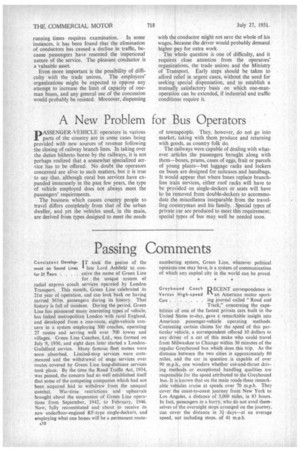More Seats in One-man Buses
Page 31

Page 32

If you've noticed an error in this article please click here to report it so we can fix it.
SHORTAGE of staff and high costs are placing road passenger transport operators in an extremely embarrassing position. Small operators of stage-carriage services, who have no spare staff and have strictly limited opportunities of subsidizing one activity by another more remunerative, are particularly hard hit.
In a recent case in which an operator was prosecuted for failing to carry a conductor on a vehicle having more than 20 seats, he replied that he had the option of either cancelling the journey or sending out the bus under the sole control of the driver. He also said that because of the difficulty of finding conductors, he had applied to the Licensing Authority for permission to discontinue the service.
Placed in an immediate difficulty of this kind, the operator is strongly tempted to break the law and risk prosecution. If he withdraws the service because no conductor is available, he is still in a quandary, because he is liable to be reported for neglecting the conditions of his licence.
The law allows operators to apply for dispensation from the need for carrying conductors, and those who are seriously affected by staff shortages should adopt this course. They should, nevertheless, first consider carefully the possible consequences of their action.
Amend the Law Operators should not be placed in a position of temptation to break the law in an effort to serve the public. That part of the Road Traffic Act, 1930, which requires that a conductor shall be carried on any vehicle with more than 20 seats is outmoded and requires immediate amendment. The existence of means whereby special dispensation from this requirement can be obtained is not adequate for the present exceptional conditions or for those which are likely to obtain in the future.
When the Road Traffic Act was passed, buses were heavy and clumsy. The 20-seater was a standard type and afforded a suitable line of demarcation between the lighter [kind of bus and the heavier models. Twenty-seaters are no longer normally built and the 32-seater 4f to-day is probably far easier to control than a maller vehicle of 20 years ago. There is a clear case for raising the limit of seating capacity for one-manoperated buses.
In any amending legislation, it would be well to consider whether seating capacity is the best test to apply. Under modern conditions, it might be more appropriate to make unladen weight the crucial factor. If it were thought desirable to continue w use the basis of seating capacity, a limit of 32 seats would be more applicable to the present day. If unladen were to be used, 5 tons might be a suitable figure. One-man-operation would, of course, have to be restricted to front-entrance vehicles.
Allow Standing Passengers At present the law precludes the carrying of standing passengers in vehicles controlled solely by drivers. This provision is also an anachronism. Peak loads have grown tremendously in the past 20 years, and there is an urgent need for standing accommodation even in one-man buses.
Until the law can be amended, the Licensing Authorities should adopt i sympathetic attitude towards applications for dispensation. A small operator has told "The Commercial Motor" that, according to a local inspector of the Ministry of Transport, the Licensing Authority in his area would in no circumstances grant dispensation, because otherwise .a precedent would be created. It is difficult to believe that a Licensing Authority would be so prejudiced and so remote from present-day conditions as to refuse out of hand a justifiable application. The Yorkshire Licensing Authority has granted permission to Huddersfield Corporation to run one-man 43-seaters for an experimental period, and has given a lead to his colleagues in this matter.
One-man operation has been extensively employed overseas for a number of years. As "The Commercial Motor" explained last week, Sweden is being forced 'by a sharp rise in wages, as well as by a labour shortage, to dispense on an increasing scale with the services of conductors.
Operators should, however, not be too hasty in seeking to follow this example. There are several questions first to be considered. For instance, the effect of the dual role of conductor and driver on running times requires examination. • In some instances, it has been found that the elimination of conductors has caused a decline in traffic, because passengers have resented the impersonal nature of the service. The pleasant conductor is a valuable asset.
Even more important is the possibility of difficulty with the trade unions. The employees' organizations might be expected to oppose any attempt to increase the limit of capacity of oneman buses, and any general use of the concession would probably be resisted. Moreover, dispensing with the conductor might not save the whole of his wages, because the driver would probably demand higher pay for extra work.
The whole question is one of difficulty, and it requires close attention from the operators' organizations, the trade unions and the Ministry of Transport. Early steps should be taken to afford relief in urgent cases, without the need for seeking special dispensation, and to establish a mutually satisfactory basis on which one-manoperation can be extended, if industrial and traffic conditions require it.






























































































